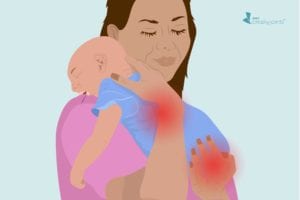You expect to hear major news and important updates for people living with arthritis and related diseases at the world’s largest medical meeting for rheumatology professionals: that of the American College of Rheumatology/Association of Rheumatology Health Professionals Annual Meeting, held in 2019 in Atlanta. This year’s meeting did not disappoint.
The CreakyJoints team was on the scene: sharing our own ArthritisPower research findings, including a patient poster from our own Jennifer Walker; poring over the research studies in the poster hall, where the thousands of studies from rheumatology researchers are shared throughout the conference; attending educational sessions with the top experts in their fields; and chatting with patients and physicians in attendance for their take on the most important findings and trends for patients back home.
After sorting through it all, reading updates from other groups covering the meeting, including RheumNow, Medpage Today, Healio, and MD Magazine, and asking our team of advisors to share the insights they really want patients to know about, we curated this guide to research and trends from ACR you should make sure to be aware of.
For more specific research on the following conditions, check out our ACR coverage on:
- Rheumatoid Arthritis (RA) Updates
- Axial Spondyloarthritis (axSpA) Updates
- Psoriatic Arthritis (PsA) Updates
- Osteoarthritis (OA) Updates
- Gout Updates
And FYI: You can participate in research studies about arthritis by using our ArthritisPower app to join our patient-centered research registry.
Here is a table of contents to the sections in this resource:
- Managing Symptoms & Disease Progression
- Doctor-Patient Communication
- Mental Health
- Methotrexate
- Medication Safety & Side Effects
- Medical Marijuana
- Exercise & Nutrition
- Managing Heart Disease
- Vaccines & Preventing Infection
- Inflammatory Bowel Disease
- Pregnancy & Family Planning
- Fibromyalgia
- Lupus
- Other Updates

Managing Symptoms & Disease Progression
1. Arthritis is a leading cause of chronic pain in America. A new study using CDC data aimed to compare the prevalence of chronic pain among arthritis patients to the U.S. population at large. The researchers determined that 48 percent of those with arthritis (all kinds, including RA, gout, lupus, and fibromyalgia) lived with chronic pain, which was substantially higher than how many people without arthritis reported having chronic pain; 22 percent of adults with arthritis had “high impact chronic pain,” defined as pain that has lasted at least three months and is severe enough to interfere with a major life activities. Read more.
2. The arthritis symptoms that matter most to patients may not be the ones they discuss with their doctor. Patient-reported outcomes (PROs) are a patient’s own assessments of how arthritis affects daily tasks and they are increasingly important in monitoring disease activity as well as measuring the success of clinical trials. Which symptoms matter the most to patients to track? When researchers, including those from our non-profit organization, the Global Healthy Living Foundation (GHLF), set out to study this, they learned that the three PROs patients cared the most about were fatigue (83 percent), pain (83 percent), and mental health (82 percent). Read more.
3. Fatigue can take a long time to improve. Fatigue is one of the most important issues for patients with all kinds of rheumatologic conditions. While treating disease often helps improve fatigue, research shows it the improvement does not happen overnight — and for some patients, fatigue can persist indefinitely. A study at ACR found that, among rheumatoid arthritis patients, 70 percent of newly diagnosed patients who initially presented with high levels of fatigue “reported significant improvements” within a year. People who did not report improvements in fatigue were more likely to also have fibromyalgia or be obese. Read more.
4. There can be a lag time between what clinical tests show and what patients feel. In one study, researchers led by Janet Pope, MD, MPH, at Western University in Ontario, saw there may be some lag time between when objective clinical tests show that patients are getting better and when patients actually start to feel better. The time it took for patients to reach remission or low disease activity varied widely depending on whether or not patient-reported factors were used as the goalpost. Knowing that this lag time of several months exists is important, because it suggests that health care providers shouldn’t necessarily rush to change up a patient’s treatment regimen if clinical scores are good; waiting it out a few months to see if pain and inflammation improve might be a better option. Read more.
5. Pain and inflammation often go together, but not always. In other research on RA patients being treated with the JAK inhibitor baricitinib (Olumiant), many people achieved inflammation control within 24 weeks, yet not everyone who had less inflammation reported corresponding improvements in pain. “Despite apparently well-controlled inflammation [swollen joint count ≤1 and CRP ≤1 mg/dL], residual pain may persist,” the authors concluded. “This may have implications for management decisions beyond treating to disease activity targets alone.” Read more.

Doctor-Patient Communication
6. Talk about treatment goals with your doctor. Do you talk to your rheumatologist about your arthritis treatment goals? Mayo Clinic researchers reported that patients with rheumatoid arthritis who did so were more likely to have less severe disease activity and achieve remission. Unfortunately, in this survey of 907 RA patients, more than 60 percent were not asked by their doctor about their goals for treatment. If this hasn’t come up in conversations with your doctor, check out this information about shared decision-making and how you can work more closely with your doctor as a team.
7. If you have questions about sexual health, bring them up to your doctor. Arthritis and related conditions can have a huge impact on sexual function, libido, intimacy, and more. But doctors may not get the necessary training or have the comfort level to bring this up with patients. A study from Northwell Health surveyed 50 health care providers and found that only 48 percent report discussing the impact of a patient’s disease on their sexuality. Some 36 percent of providers said they never discuss it, though two-thirds of those surveyed agreed that sexual health issues are relevant to rheumatology. While this research certainly implies that doctors need more training in this area, what it means for patients is that you should not wait for your physician to bring up this topic if you are experiencing sexual health issues — you may need to broach it instead. Read more about how arthritis can affect your sex life.

Mental Health
8. Physical activity plays a role in depression risk. It’s important to recognize that depression is very common among people with rheumatic disease — all kinds of disease, in all kinds of patients, in all kinds of communities. What was interesting about this research from Mexico was that patients with an inactive lifestyle as well as those who reported more sedentary behavior were more likely to experience depression than those who were more active. There is some chicken-egg logic here, as depression can also affect motivation and make people less active, but it is interesting to look as physical activity as a possible intervention for preventing or treating depression.
9. Depression may affect seropositive and seronegative rheumatoid arthritis differently. Researchers at Brigham and Women’s Hospital, led by rheumatologist Jeffrey Sparks, MD, reported that depression is a risk factor for seronegative but not seropositive RA. “This is interesting and contributes to knowledge of differences between these two dominant subtypes of rheumatoid disease,” Mayo Clinic rheumatologist John Davis, III, MD, told CreakyJoints. This knowledge can help doctors and researchers better understand the differences in what causes seronegative versus seropositive RA, “which could improve treatment options,” Dr. Davis says.
10. Depression is prevalent in psoriatic arthritis, but treating the underlying disease helps. Previous research has indicated that people with psoriatic arthritis may have higher rates of depression than even people with other rheumatic diseases, so understanding how to treat this is of utmost importance. Now, new data shows that patients who took biologic medications for PsA — in one study they were on the TNF blocker golimumab (Simponi); in two others, they were on the IL-12/23 blocker ustekinumab (Stelara) — experienced a significant improvement in depression symptoms. “There is a lot we can do for our patients with depression, and the first step is to treat the underlying condition,” said NYU Langone rheumatologist Olga Petryna, MD, reporting for RheumNow.
11. Having PTSD, depression, and anxiety could affect how well patients stick to their medication regimen. In a study on U.S. Veterans with rheumatoid arthritis, researchers sought to examine whether having post-traumatic stress disorder, depression, or anxiety could affect patients’ medication adherence. There was, indeed, a connection. Veterans with RA and a diagnosis of PTSD, depression, or anxiety discontinued disease-modifying medications (including methotrexate and TNF biologics) sooner than those without these diagnoses. More research is needed to understand how these mental health conditions affect patients’ medication adherence.

Methotrexate
12. A large trial shed more light on potential side effects of methotrexate. As a first-line drug for RA and also used for other types of inflammatory disease, methotrexate is very commonly prescribed. It also raises a lot of concerns for patients about potential side effects, perhaps because of its historical use as a chemotherapy drug (albeit in much higher doses). Harvard researchers, led by rheumatologist Daniel Solomon, MD, did an analysis on a large group of patients who did NOT have inflammatory arthritis taking methotrexate as part of a separate study to see if the drug could prevent heart disease in people without RA. (It didn’t.)
But this new analysis of the randomized controlled trial — in which 2,350 people were taking MTX and compared with an equal-sized group on a placebo — was an interesting way to study the types of side effects of methotrexate at the dosages that are used to treat RA. The trial was “one of the largest experiences with low-dose methotrexate in adult patients,” Dr. Solomon told MedPage Today, since previous research on this topic has been limited to observational studies and much smaller randomized trials.
What they found: There was about a 20 percent increased risk of adverse events in the MTX group; most were mild and included GI problems and nausea, mouth sores, and issues with blood count, such as anemia and a reduction in white blood cells. There was also a 15 to 20 percent increased risk of infections, such as upper respiratory illness, compared to placebo. One surprising finding, Dr. Solomon pointed out, was an increased risk of skin cancer among people on MTX. This could be especially relevant to patients with psoriasis and psoriatic arthritis, who have an increased risk of skin cancer to begin with.
“I think these [results] will inform future guidelines about the safe prescribing of methotrexate,” Dr. Solomon told MedPage. “I don’t want to leave people with the impression that methotrexate is a more dangerous drug than you would realize. I think most rheumatologists recognize it has its toxicities, we know how to monitor it, we do that carefully, but we just have to recognize, just like our other DMARDs, it also has toxicities.” Read more.
13. Patients have mixed feelings on methotrexate — and doctors could do a better job of educating on what side effects to expect. Do patients’ concerns about potential bothersome effects of methotrexate impact whether they take it? When researchers, including those from our nonprofit organization, the Global Healthy Living Foundation, set out to study this, they learned that patients commonly reported fatigue and GI upset as bothersome side effects. Patients who stopped taking methotrexate reported having substantially more gastrointestinal issues — including nausea, abdominal pain, and loss of appetite — from methotrexate than current users did. However, despite many patients reporting side effects, those who currently take methotrexate consider the drug important in managing their disease and health. Read more.
14. Patients may need the injectable form of methotrexate to achieve the optimal dose. As a first-line disease-modifying therapy for RA, methotrexate has changed the course of disease for countless patients, Harvard Medical School rheumatologist Michael Weinblatt, MD, told the ACR Daily News. But questions related to delivery and dosing remain. He noted that as methotrexate dosage increases from 15 mg to 25 mg, the “bioavailability” — or how much your body is able to absorb — of the oral form of the drug becomes significantly less. “Subcutaneous [injectable] methotrexate offers the advantage of providing 100 percent of the drug to the patient.”
“Generally speaking, if you’re going to do doses greater than 20 mg per week and you want to ensure absorption for the patient, the subcutaneous option is very attractive,” Dr. Weinblatt said. “If you’re not getting the results you’d like, before you assume that patients are methotrexate non-responders and decide to add a biologic or a JAK inhibitor, which can carry significant costs, you really should consider first-dose escalating methotrexate to 20 to 25 mg per week either given subcutaneously or split-dose oral, giving them at least four to six weeks to respond.”
15. Methotrexate may have an independent impact on lowering heart disease risk in RA. It’s well-known that RA patients have an increased heart disease risk and that taking methotrexate appears to reduce that risk. But is the connection simply because methotrexate reduces disease activity, or does it have another mechanism of heart-protective action? Researchers studied a group of U.S. Veterans with RA over the course of 10 years. They found that MTX use was associated with a 30 percent reduced risk of various cardiovascular disease events (such as heart attack and stroke) and a 60 percent reduced risk of congestive heart failure hospitalizations. They concluded that “the protective effect of MTX was independent of other factors, including treatment-related changes in disease activity,” which suggests that there are additional reasons methotrexate helps to lower heart disease risk in RA patients.

Medication Safety & Side Effects
16. Doctors are seeking more information about JAK inhibitors and VTE risk. Venous thromboembolism — when blood clots form in the veins, often in the legs, and then travel throughout the body — is a known potential side effect from JAK inhibitor medications, but more research and understanding is needed to help protect patients and optimize treatment. In particular, doctors need to better understand what about JAK inhibitors may be causing an increased risk of VTE in order to identify which patients are at risk and to intervene, University of Massachusetts rheumatologist Jonathan Kay, MD, said during a RheumNow panel discussion.
If you have risk factors for VTE, you should talk to your doctor before starting a JAK inhibitor.
17. Long-term glucocorticoid use is linked to serious infections — even in low doses. It’s well-known that taking steroids to manage RA or other inflammatory diseases can increase the risk of infection, but there’s not as much research on the extent of this risk in people taking low doses of steroids (less than 5 mg a day). Using data from Medicare patients, researchers, led by University of Pennsylvania rheumatologist Michael George, MD, found that long-term use of glucocorticoids is associated with a significant increase in the risk of serious infections, even at doses of 5 mg/day or lower.
18. A large study reported reassuring news about cancer risk and biologic drugs. French researchers looked at a national claim database that included 83,706 rheumatoid arthritis patients who took either conventional disease-modifying drugs (DMARDs) or biologics and found that the risk of developing organ-specific cancers and blood cancers did not differ between patients who were taking conventional vs. biologic DMARDs. “This confirms what we know: that biologics really don’t increase the risk of cancer or lymphoma,” UT Southwestern Medical Center rheumatologist Kathryn Dao, MD, reported for RheumNow.
19. Serious infections in anti-TNF biologics are not common. A Spanish study that looked at medical records of inflammatory arthritis patients being treated with anti-TNF biologics over the course of three year found that only about 10 percent of patients had a serious infection (one that required hospitalization). Comorbidities like diabetes and concurrent steroid use increased that risk.

Medical Marijuana
20. The popularity of medical marijuana lags way behind clinical evidence. This was eye-opening: Less than 200 patients have been studied in randomized controlled trials for patients with rheumatological conditions, according to Mary-Ann Fitzcharles, MD, a rheumatologist and pain medicine specialist at McGill University in Montreal, Canada, during an ACR session called Cannabinoids: The Science for Pain Therapy, reported the ACR Daily News. She noted that “preclinical” evidence is compelling, with cannabinoids showing an excellent effect on acute and chronic pain and inflammation. Doctors need to do more to educate patients on therapeutic dosing, she added.
But that’s a problem, because, as noted below, many physicians are reluctant to talk about cannabis with their patients.
21. Rheumatologists are split on whether marijuana and CBD should be used to treat rheumatologic conditions. When researchers at the University of Vermont Medical Center surveyed rheumatology clinicians about their patients’ usage of medical marijuana and CBD, they found that 45 percent of more than 100 doctors disagreed that marijuana or CBD should be recommended as medical therapy for people with rheumatologic conditions.
Legality may play a role: More doctors who practiced in states where marijuana was legal for medical and recreational use said they were comfortable addressing questions about usage than in states where it was not legal. The authors concluded that “surrounding laws likely impact clinician perception and comfort with medical use.”
22. The legal status of medical marijuana affects patient habits. When researchers surveyed 1,059 patients through the CreakyJoints patient community and the ArthritisPower research registry, legality also played a big role in patient perceptions and habits. Of the approximately two-thirds of patients surveyed who said they had never used marijuana for medical purposes, 40 percent said illegality was a factor.
There was also a link between whether medical marijuana was legal where patients lived and whether patients spoke with their doctor about their usage. Among patients who live in states where marijuana is medically legal, 68 percent said they told their doctor about using it, while only 54 percent of patients in states where medical marijuana was not legal talked with their doctor about it.
“It’s alarming that not everyone is telling their doctor about their marijuana use, regardless of its legal status,” says study co-author W. Benjamin Nowell, PhD, director of Patient-Centered Research at the Global Healthy Living Foundation. “It is important that your rheumatologist and other providers are aware of what you might be using in addition to prescribed medication.” Read more.

Exercise & Nutrition
23. Omega-3 supplements were associated with lower disease activity in RA patients. Researchers at Brigham and Women’s Hospital looked at the association between omega-3 supplementation and disease activity in patients being followed for many years as part of the long-term Brigham and Women’s Rheumatoid Arthritis Sequential Study (BRASS). They found that after a year of taking supplements, omega-3 users were more likely to have significantly fewer painful or swollen joints and to have lower disease activity scores. Read more.
24. A plant-rich diet may reduce RA risk — but it may be more about weight management than specific foods. Brigham and Women’s researchers analyzed data on 79,465 women from the original Nurses’ Health Study (NHS) and on 95,741 women from a second group, the Nurses’ Health Study II (NHS II) who did not have RA at the time they started keeping records of their diet. While the researchers found that consuming a healthy plant-based diet — rich in whole grains, fruits, vegetables, and nuts — may be associated with a modest reduction in RA risk, it seemed to be affected by body mass index. In other words, eating this way allows people to maintain a healthy body weight, and that, in turn, may be responsible for RA risk reduction. It seems like more evidence that there are no “magic” foods for inflammatory arthritis; rather, overall healthy dietary patterns are what impact patients’ health.
25. Primary care doctors and patients aren’t talking enough about physical activity and arthritis. A CDC study found that nearly one-third of primary care providers aren’t asking patients about their physical activity or recommending physical activity as part of arthritis management. “While many adults with arthritis fear that physical activity will cause pain, routine physical activity can reduce pain levels comparable to NSAIDs,” Dana Guglielmo, MPH, of the CDC’s Arthritis Program, told Healio Rheumatology. “Adults with arthritis need and want their health care provider to counsel them on how to become physically active.”
26. Your ‘exercise identity’ could affect recovery and activity after joint replacement surgery. After undergoing knee replacement surgery, study participants filled out a survey at their physical therapist that assessed their “exercise identity” — the degree to which they viewed themselves as an exerciser. Researchers found that people with positive exercise identity take more daily steps and spend more time standing after knee replacement, so patients may benefit from messages and programs that are tailored to their exercise identity.
27. Yoga helps improve fatigue and mental health. Say ohm: Croatian researchers found that yoga led to a significant improvement in fatigue, depression, and anxiety in rheumatoid arthritis patients. The study was small (only 43 patients) but authors suggest that yoga could benefit people with RA as “supplementary non-pharmacological treatment.”

Managing Heart Disease
28. Taking hydroxychloroquine for RA or lupus can reduce heart risk by 17 percent. If you take the anti-malarial drug hydroxychloroquine (Plaquenil) as part of your treatment for lupus or rheumatoid arthritis (RA), you may be getting cardiovascular protection as an added bonus, a study showed. In another hydroxychloroquine study, Johns Hopkins researchers looked at blood levels of the medication in lupus patients who developed a blood clot (including heart attacks and clot-caused strokes). They found that patients with the highest levels of hydroxychloroquine in their bloodstream were the least likely to have developed a clot. Read more.
29. The Vectra multibiomarker disease activity blood test can help identify cardiovascular risk in RA. University of Alabama rheumatologist Jeff Curtis, MD, and colleagues evaluated data 30,751 Medicare patients over a 10-year period. They showed that the Vectra test, which is a blood test that measures inflammation as well as multiple biomarkers that can help predict a rheumatoid arthritis patient’s risk of radiographic progression, was better than other models at predicting which RA patients would go on to have a cardiovascular event such as heart attack or stroke. “This test is the first of its kind to be able to predict outcomes in our patients,” Dr. Curtis told Healio Rheumatology. “It will help us have a discussion about getting patients rheumatoid arthritis under control overall.”
30. African Americans with lupus face a very high risk of cardiovascular problems, which peak close to diagnosis. A study conducted by researchers from the University of Wisconsin School of Medicine and Public Health and Emory University found that African Americans with lupus were 18 times more likely than Caucasian patients to have a cardiovascular event during a 10-year period. The researchers also noted that cardiovascular incidents peaked within one to two years of diagnosis. “Future [cardiovascular disease] prevention efforts should target such populations to reduce racial disparities, particularly around the period of [lupus] diagnosis,” the authors wrote. Read more.
31. Research into cardiovascular disease in spondyloarthritis is an increasingly hot topic. According to rheumatologist Jean Liew, MD, a senior fellow at the University of Washington, who was the lead author of a study on this subject, new research included a look at biologic therapies and their effects on heart disease, such as measures of atherosclerosis; on the presence of cardiovascular risk factors such as metabolic syndrome and how that is associated with radiographic progression; and whether cardiovascular risk is well-understood in SpA patients, which is what Dr. Liew’s team studied. Stay tuned for more research into this area, especially as the recognition and diagnosis of SpA increases and more treatment options become available.

Vaccines & Preventing Infection
32. The live shingles vaccine didn’t cause problems for patients on biologics. People with inflammatory arthritis are about twice as likely to get shingles as otherwise-healthy adults, which is likely due to immune dysfunction from the disease itself and/or immune- suppressing drugs people take to treat their arthritis. Many patients worry about getting the live shingles vaccine (Zostavax) because of fears that it could actually cause a shingles infection in people taking immunosuppressive drugs. A new study, led by rheumatologist Jeffrey Curtis, MD, of the University of Alabama, randomized 617 patients taking a TNF inhibitor for rheumatoid arthritis, psoriatic arthritis, or another condition, to get the live shingles vaccine or a placebo injection, then followed them for six weeks (which is the amount of time the Food and Drug Administration considers people at risk for vaccine-related infections). The encouraging results: zero cases of shingles or a local zoster infection near the injection site. Eight patients developed a rash, but none were positive for the virus.
We still need more data, University of Calgary rheumatologist Steven Thomson, MD, told CreakyJoints, but this research “looks promising for those who can’t afford the inactivated vaccine.” Read more.
33. Preliminary research on the Shingrix shingles vaccine in inflammatory arthritis patients looks safe. The other type of shingles vaccine, Shingrix, is not a live vaccine, but presents potential issues for inflammatory arthritis patients for another reason. It’s a very strong vaccine and there are theoretical concerns that it could cause disease flares, especially since inflammatory arthritis patients were not included in the original trials of the Shingrix vaccine. University of Tennessee researchers looked at 47 patients who had received the Shingrix vaccine (most of them had rheumatoid arthritis) in 2018. They found that the vaccine was well-tolerated and there were no changes in levels of the inflammatory marker C-reactive protein or disease activity as measured by patient-reported outcomes.
34. Flu shots are very important and arthritis patients should get one every year. Reporting on a session about immunizations in immunosuppressed patients for RheumNow, Cleveland Clinic rheumatologist Cassandra Calabrese, DO, noted that “all of our patients should be getting a seasonal flu shot every year. There are very few contraindications to seasonal flu vaccine. If you have an egg allergy, you can have a flu vaccine. The only true contraindication is anaphylaxis to a previous flu vaccine or if you’ve had Guillain-Barré syndrome in the setting of a previous flu vaccine.”
35. The high-dose flu vaccine may be helpful in inflammatory arthritis patients. There is a relatively new version of the flu vaccine available, called the high-dose trivalent inactivated influenza vaccine. It is “stronger” than other types of flu vaccines and it is currently FDA-approved only for adults age 65 and older (because our immune response to the flu vaccine naturally decreases with age). Now, new data from McGill University shows that the same high-dose vaccine may improve the immune response in rheumatoid arthritis patients who are under the age of 65. “The high-dose vaccine does work really well in these patients, and this is the kind of protection we need to be giving our rheumatoid arthritis patients, especially as we get into influenza season,” Australian rheumatologist David Liew reported for RheumNow.
36. Many arthritis patients don’t get hepatitis screening before starting a biologic. Before you start taking a biologic drug or one of the new targeted synthetic disease-modifying anti-rheumatic drugs (DMARDs), several screening tests are recommended, including for hepatitis. But a new study reveals that fewer than one in four patients in a national registry received hepatitis screening before starting these medications. Read more.

Inflammatory Bowel Disease
Gastrointestinal issues are common in arthritis patients, and inflammatory arthritis is common in people with inflammatory bowel disease. It’s important that the ACR meeting had a lot of research about the intersection of inflammatory arthritis and inflammatory bowel disease, such as this:
37. Rheumatologists and patients should talk more about digestive issues in order to identify IBD. “Please suspect IBD more often,” David T. Rubin, MD, professor of medicine, co-director of the Digestive Diseases Center, and chief of gastroenterology, hepatology, and nutrition at the University of Chicago, said to rheumatologists in an ACR session, Healio Rheumatology reported. He cautioned rheumatologists to be on the lookout for issues that could suggest IBD and then refer patients to a gastroenterologist. These include unusual dietary habits, such as eliminating foods from the diet because of GI issues, unexplained weight loss or blood in the stool, anemia, or low levels of vitamin D or B12.
38. About 25 percent of IBD patients have chronic back pain; many likely have spondyloarthritis. In an attempt to better quantify the incidence of chronic back pain among IBD patients, researchers led by Oleg Stens, MD, at Harbor-UCLA Medical Center analyzed two massive health surveys (NHANES 2009-10 and NHANES II) that contained data on a total of nearly 19,000 Americans. They found that nearly 25 percent of IBD patients had experienced chronic low back pain and also estimated that about 10 percent of IBD patients had spondyloarthritis (SpA). Read more.
39. Sacroiliitis is common in Crohn’s disease. But it may be underdiagnosed because Crohn’s patients don’t associate back pain with GI symptoms and may not be aware of the link between IBD and inflammatory arthritis. A study lead by NYU rheumatologist Fardina Malik, MD, found that gastrointestinal doctors can use an imaging technique called magnetic resonance enterography as a screening tool to check patients for sacroiliitis (inflammation of the sacroiliac joints) and then refer to a rheumatologist for further evaluation.

Pregnancy & Family Planning
This is an increasingly prominent topic at ACR meetings, with researchers exploring important questions for people concerned about how chronic inflammatory disease can affect their health during conception and pregnancy, as well as the health of their future children. It’s great to see so much research on reproductive health because a decade ago there was very little, noted UC San Diego rheumatologist Arthur Kavanaugh, MD, during the conference’s Rheumatology Round-Up session. “There’s a growing amount of data on pregnancy. You can’t just ignore fertility issues, outcomes of pregnancy, lactation issues,” he said. We’re learning more and more, he added, “that the best thing for a healthy baby is a healthy mom.”
40. Most babies exposed to biologics in utero do not experience serious infections. Last year, researchers at McGill University in Canada found that that there was no increased risk of infection in babies who were exposed to anti-TNF biologics compared to the offspring of women with RA who didn’t take these drugs as well as to women without RA at all. This year, the researchers presented a similar analysis of serious infections in babies exposed to non-TNFi biologics and found that they too, led to few infections in babies after they’re born. Read more.
41. Staying on biologic medication during pregnancy reduces the risk of arthritis flares. Two different studies — one Spanish and Italian, one German — addressed the question of what happens to pregnant women depending on whether or not they remain on their biologic during pregnancy. Both concluded that stopping biologics increased the risk of having flares; the German authors found that women who stopped their biologic also had an increased need for steroids. The other research team concluded, “patients with more aggressive RA may get benefit from continuing treatment beyond conception to ensure control of maternal disease and better pregnancy outcomes.”
42. Many new moms with rheumatic diseases are successfully breastfeeding. It’s natural to worry about whether you can breastfeed with a rheumatic disease (in part because of concerns over which medications are safe). Researchers from Duke University surveyed and followed 265 pregnant women with rheumatic diseases about their plans to breastfeed. They found that a large majority of women planned to breastfeed and were breastfeeding (sometimes along with formula) at follow-up. Women with more education and women who did not have pre-term births were more likely to breastfeed. The authors concluded, “the majority of women with rheumatic disease want to breastfeed and, given the safety of our medications for lactation, the large majority can do so successfully.”

Fibromyalgia
43. Monitoring tender points is becoming less relevant. In a session about fibromyalgia management, University of Michigan rheumatologist Daniel Clauw, MD, shared that evaluating tender points isn’t that relevant now and there are other ways doctors can evaluate the way fibromyalgia affects sensitization, such as asking questions like “Are you uncomfortable when people hug you?” or “Are you uncomfortable when people take your blood pressure?”
“[Fibro] is chronic widespread pain disorders, not just a focal pain disorder,” Philip Robinson, a rheumatologist in Brisbane, Australia, reported on the session for RheumNow.
44. Fibromyalgia patients rarely have just one type of pain. Doctors should think about the proportion of each type of pain a patient has — for example, nociceptive pain (pain due to damage to the body, such as from inflammation or injury); neuropathic pain (pain from nerve damage); or centralized pain (pain due to how your nervous system processes pain) — in order to improve treatment and outcomes.
“You’re never going to make any progress unless you target the cause of people’s pain,” Dr. Robinson says.
45. Opioids are not effective for fibromyalgia in the long term. They may help in the beginning, but the longer patients are on them and the higher the dose, the less effective they are, according to Dr. Robinson. The fibromyalgia session noted that there are more effective therapies, including SNRI antidepressants, anti-seizure drugs, and tricyclic antidepressant medications. There is also burgeoning evidence for non-pharmacological treatments, including cognitive behavioral therapy and regular physical activity. Doctors need to “put together a combination of treatments,” says Dr. Robinson. Read more about treatment options for the whole fibro patient.
46. Fibro patients may have a history of abuse. No one knows what causes fibromyalgia but some experts believe that stress may be a common trigger, especially in people who are susceptible for physiological reasons. Now a new study from the Cleveland Clinic adds support to the theory that psychological stress might increase the risk. Researchers enrolled 593 fibromyalgia patients and surveyed them about their symptoms and history of abuse. Nearly 38 percent of fibromyalgia patients said that they had been physically and/or sexually abused at some point. The authors recommend that physicians ask patients who are being evaluated for fibromyalgia about their history of abuse, as “this may give more clarity to the nature and severity of the [fibromyalgia] presentation and prompt the need for psychological interventions.” Read more.
47. Stigma for fibromyalgia is still a concern. Rheumatoid arthritis and fibromyalgia are common conditions in rheumatology, but while RA is perceived as a “valid” medical condition, those with fibromyalgia do not always get the same recognition for their painful condition. Israeli researchers set out to study physicians’ perceptions of RA and fibro and how that might affect patients’ access and care. They found that 98 percent of doctors would accept RA patients, but only 56 percent would accept fibro patients. Fibromyalgia patients were perceived as being more difficult than RA patients, with a large burden of symptoms and a lack of control on their disease, the authors concluded. “Improving illness understanding and providing coping skills to rheumatologists may improve doctors-patients relationships and outcomes,” they wrote.
48. Fibromyalgia patients may require professional support. Researchers from Rush University Medical Center in Chicago sought to better understand on whom fibro patients rely for emotional support, noting that the condition causes intense symptoms, especially pain and fatigue. They surveyed 115 fibromyalgia patients and found that they most often rely on their spouse/partner (63 percent) and friends (57 percent) while less commonly using professional support (21 percent). The authors noted that fibromyalgia likely puts a significant strain on relationships and patients who need it should be encouraged and helped to find and receive professional support.

Lupus
49. Clinical trials have been challenging, but the future is bright. Twenty phase 2/3 trials for lupus have failed over the years for various reasons (including poor design and implementation or a lack of safety or efficacy of the medication), noted Cedars-Sinai rheumatologist Daniel Wallace, MD, in the ACR Daily News. Studying lupus in clinical trials is complicated, he shared, because of the heterogeneity of the disease. However, “despite the ups and downs in lupus … we’re making progress, bit by bit,” Richard Furie, MD, chief of the division of rheumatology at Northwell Health, said in the paper. “I do think the future is bright for our patients.”
50. A new medication called anifrolumab is seeking FDA approval next year. It’s hardly a slam dunk: There were two phase 3 trials conducted on anifrolumab. One of them did not hit its primary endpoint, though secondary endpoints suggested that the drug had benefits. The second phase 3 study, which was presented for the first time at ACR, yielded more consistently positive results. Read more about how the drug works and who might be a good candidate for it.
51. Other lupus medications did well in phase 2 trials. One drug, obinituzumab (Gazyva), is for patients with lupus nephritis. Already FDA-approved to treat certain forms of leukemia, it targets CD20 antibodies, which are found on certain immune system cells called B lymphocytes that are involved in lupus. Investigators reported good results and will pursue phase III studies, according to CreakyJoints medical advisor Vinicius Domingues, MD.
A separate study on the medication telitacept found that it was effective and well-tolerated in systemic lupus erythematosus (SLE).
52. The biologic belimumab helps lupus patients reduce their use of steroid medications. Belimumab (Benlysta) was the first new treatment specifically for lupus in more than 50 years when it was approved nearly 10 years ago; researchers are continuing to study how it affects disease management in patients long-term. In examining “real-world evidence” (not from randomized controlled clinical trials) from hundreds of studies, researchers saw reduced disease activity after belimumab treatment in 51% and 77% of SLE patients at six months and one year, respectively. The medication also led to a decrease in steroid dosages and even complete discontinuation of steroids in up to 11 percent of patients.
53. The brand-name version of hydroxychloroquine (Plaquenil) may be better for lupus patients who can’t tolerate it for GI issues. In a RheumNow report, UT Southwestern Medical Center rheumatologist Kathryn Dao, MD, shared some insights from a talk from Johns Hopkins lupus expert Michelle Petri, MD. Dr. Petri shared that if patients have hydroxychloroquine intolerance because of gastrointestinal issues, the brand-name medication Plaquenil may help because it is coated and could cause less GI intolerance.
54. Weather may affect lupus symptoms. Shifts in weather patterns have long been associated with a variety of health ailments. Now a new study suggests that changes in the outdoor environment may make people who have lupus more susceptible to flare-ups of specific symptoms. Researchers, led by George Stojan, MD, of the Johns Hopkins Lupus Center, found that as the temperature increased, so did the risk of rash, joint inflammation, kidney problems, serositis (inflammation of smooth tissue membranes), and hematologic problems such as anemia and low white blood cell count. Read more.

Other Updates
55. New guidelines will help standardize and improve care for vasculitis patients. The ACR’s first-ever vasculitis clinical guidelines were presented at the ACR meeting, covering seven different diseases under the umbrella of vasculitis: giant cell arteritis (GCA), Takayasu’s syndrome (TAK), polyarteritis nodosa (PAN), Kawasaki disease, and three types of ANCA-associated vasculitis. One of the key themes of the guidelines was increased use of non-steroid medications, which until now have been a primary way of treating these diseases for decades. The guidelines are still undergoing peer review and should be published next year.
56. The biologic tocilizumab (Actemra) helps people with giant cell arteritis (GCA) remain in remission even after stopping it. The interleukin-6 inhibitor was FDA-approved for GCA — an inflammation of the lining of the arteries — in 2017 due to research showing that the drug was better than prednisone (a steroid) for helping many patients reach remission in GCA. Now new data shows that a sizeable group of people who reached remission with tocilizumab were still in remission two years after stopping the drug. “Patients should be started on tocilizumab as soon as they are diagnosed,” lead author John H. Stone, MD, MPH, told the ACR Daily News. “The goal should be to get them off steroids as quickly as possible and maintain their response with tocilizumab.” Read more.
57. MRI can make it easier to diagnose polymyalgia rheumatica (PMR). A Japanese study showed that using MRIs in the shoulders of people with suspected polymyalgia rheumatica — an inflammatory condition known for causing pain, especially in the shoulders — may contribute to more accurate diagnosis and prediction of recurrence. PMR is clinically diagnosed based on symptoms, but accurate diagnosis is difficult because the symptoms may occur in many other rheumatic diseases.
“Most of the time PMR is easy to identify, but sometimes it’s not,” rheumatologist Paul Sufka, MD, social media editor for the medical journals of the American College of Rheumatology, told CreakyJoints. “Our patients do best when we correctly identify what is going on, and evidence that MRI can be used to sort out if patients have active PMR might help them avoid unnecessary exposure to prednisone.”
Rheumatoid Arthritis: It’s Time for More Personalization
There was were so many important updates for RA patients that we included them in a separate article. Read it here.
Axial Spondyloarthritis: A Spotlight on Non-Radiographic
There was were so many important updates for axSpA patients that we included them in a separate article. Read it here.
Psoriatic Arthritis: An Expanding Toolkit
There was were so many important updates for PsA patients that we included them in a separate article. Read it here.
Gout: New ‘Treat-to-Target’ Guidelines
There was were so many important updates for gout patients that we included them in a separate article. Read it here.
Osteoarthritis: New Guidelines Call for an Integrated Approach
There was were so many important updates for osteoarthritis patients that we included them in a separate article. Read it here.
You Can Participate in Arthritis Research Too
If you are diagnosed with arthritis or another musculoskeletal condition, we encourage you to participate in future studies by joining CreakyJoints’ patient research registry, ArthritisPower. ArthritisPower is the first-ever patient-led, patient-centered research registry for joint, bone, and inflammatory skin conditions. Learn more and sign up here.






